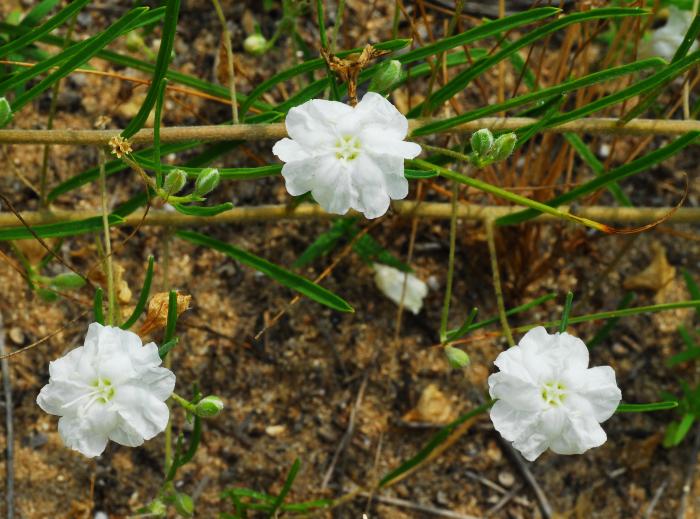Stylisma pickeringii (Torr. ex M.A. Curtis) A. Gray
Stylisma

Native
CC = 10
CW = 3
MOC = 2
SRank = S1
© SRTurner
Stylisma pickeringii (Torr. ex M.A. Curtis) A. GrayStylisma | |
 |
Native CC = 10 CW = 3 MOC = 2 SRank = S1 |
© SRTurner |
|
Family - Convolvulaceae Habit - Perennial forb, with deep-set roots. Stem - Prostrate, scrambling but not twining, to 2 m, pubescent with appressed, usually 2-branched hairs.
Leaves - Alternate, sessile or nearly so, simple, entire, linear, 2-6 cm long, bluntly to sharply pointed at the tip, narrowed or tapered at the base, the surfaces glabrous to moderately and minutely hairy.
Inflorescences - Axillary, the flowers solitary or in loose clusters of 2-5, usually long-stalked. Bracts 2 per flower, but often appearing clustered at the tip of the inflorescence stalk, 5-25 mm long, herbaceous, usually about as long as the flower stalk and calyx but not hiding the calyx, not overlapping, linear, usually persistent at fruiting.
Flowers - Sepals free, 4-6 mm long, similar in size and shape, oblong-ovate to oblong-elliptic, herbaceous to somewhat thickened, densely and finely hairy on the outer surface. Corollas 1.2-1.8 cm long, very shallowly 5-lobed, broadly funnelform to nearly bell-shaped, white. Stamens lacking subtending scales, more or less exserted. Ovary 2-locular, with 4 ovules, densely hairy. Style 1, unequally 2-lobed toward the tip, the stigmas thus 2 per flower, capitate.
Fruits - Capsules 5-9 mm long, ovoid, 1- or 2-locular, dehiscing longitudinally into 2-4 segments.
Flowering - June - September. Habitat - Sand prairies, levees, open areas with sandy substrate. Origin - Native to the U.S. Other info. - This interesting member of the morning glory family was first documented in Missouri only in 1989, and is currently known in the state from only two counties, Clark and Scott, which are far distant from each other. It is considered critically imperiled in the state, and beyond Missouri its range is relatively small, confined mostly to portions of Oklahoma, Louisiana, and Texas. The plant is easily recognized by its prostrate habit, linear leaves, and white flowers of the morning glory pattern. It is highly specific to sand prairies, though it can apparently persist after degradation or destruction of the original habitat. Photographs taken at Sand Prairie Conservation Area, Scott County, MO, 6-17-2013 and 7-30-2015 (SRTurner). |